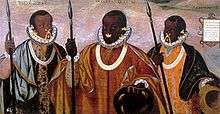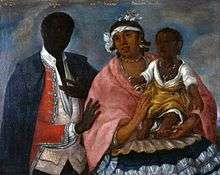Zambo
Zambo (Spanish: [ˈθambo] or [ˈsambo]) and cafuzo (Portuguese: [kɐˈfuzu]) are racial terms historically used in the Spanish and Portuguese empires referring to people of mixed Indian and African ancestry. Occasionally in the 21st century, the term is used in the Americas to refer to persons who are of mixed African and Amerindian ancestry. (The analogous English term, sambo, is considered a slur.) Historically, the racial cross between enslaved Africans and Amerindians was referred to as a zambayga, then zambo, then sambo.
 16th-century painting of Zambo caciques from Esmeraldas, Ecuador | |
| Total population | |
|---|---|
| 5,804,800 in South America, unknown number overall[1] | |
| Regions with significant populations | |
| Latin America and the Caribbean | |
| Languages | |
| Spanish, Portuguese and English | |
| Religion | |
| Christianity (predominantly Roman Catholic, minority practices Protestantism), tribal religions | |
| Related ethnic groups | |
| Garifuna, Africans, Afro-Caribbeans and Amerindians |
Background
The meaning of the term sambo; however, is contested in North America, where other etymologies have been proposed. The word is believed to have originated from one of the Romance languages or Latin and its direct descendants. The feminine word is zamba (not to be confused with the Argentine Zamba folk dance.)
In some parts of colonial Spanish America, the term zambo applied to the children of one African and one Amerindian parent, or the children of two zambo parents. In New Spain (colonial Mexico), the term for those of mixed African and indigenous ancestry was lobo ("wolf"). This term of classification appears in official marriage registers and other official documentation.[2]
During this period, many other terms denoted individuals of African-Amerindian ancestry in ratios smaller or greater than the 50:50 of zambos: cambujo (zambo-Amerindian mixture) for example. Today in parts of Spanish America, zambo refers to all people with significant or visible amounts of both African and Amerindian ancestry.
History


The term zambo was not formally used in Spanish territories. Competing terms, such as mulato, were also used. From the beginning the early sixteenth century, when African slaves were first imported to Hispaniola, unions between them and indigenous peoples, and Spanish colonists, began to take place. The two non-European groups sometimes worked together in the mines or on the plantations of Hispaniola, and on other Spanish Caribbean islands following the introduction of sugar cane production in the 1520s. In other cases, Africans took refuge in indigenous communities after escaping slavery.
The term zambos was generally used to refer to persons who did not have European ancestry, but all sorts of unions took place through the centuries, of course. In the eighteenth century, the Spanish began making formal racial classifications, and defined zambo in what became its final, official meaning.
Some zambo groups became well-known after being created by runaway or rebel Africans who mixed with or took over indigenous communities. In the unconquered regions of Esmeraldes, in what would become Ecuador, for example, a small group of shipwrecked former slaves gained control of some indigenous communities, eventually representing them before Spanish authorities in the late sixteenth and early seventeenth centuries.
The Misquito Zambos developed as the descendants of a group of African slaves who revolted in 1640 on a slave ship. They wrecked it at Cape Gracias a Dios on the border between Honduras and Nicaragua, in order to escape into the interior. There they united with the indigenous Miskito people. By the early eighteenth century, Afro-Miskito people came to dominate the kingdom. They led warriors on many extensive slave raids to capture slaves for sale to Europeans. Their alliance and protection of English-speaking merchants and settlers in the area helped Great Britain found the colony of British Honduras (present day Belize).
Population today

Officially, zambos represent small minorities in the northwestern South American countries Colombia, Brazil, Venezuela, Guyana, and Ecuador. A small but noticeable number of zambos, resulting from recent unions of Amerindian men to Afro-Ecuadorian women, are not uncommon in major coastal cities of Ecuador. Prior to the rural to urban migration in Ecuador, the Amerindian and Afro-Ecuadorian ethnicities were constrained mostly to the Andes region and province of Esmeraldas, and the Chota Valley in the province of Imbabura, respectively.
In Central America, two indigenous-African mixed groups have developed: the Miskito and the Garifuna. The Garifuna originated from the combination of Africans who were either shipwrecked or fled from neighboring islands to St. Vincent, in the course of the seventeenth and eighteenth centuries. In 1797 they were deported by the English, for their role in supporting France during the French Revolutionary Wars, to the island of Roatan off the coast of Honduras. From there they reached the mainland, developing communities along the coast of Central America, from Nicaragua to Belize.
In Mexico, where zambos were sometimes known as lobos (literally meaning wolves), they form a sizeable minority. According to the 2015 Intercensus Estimate, 896,829 people identified as both Afro-Mexican and Indigenous Mexican. The great majority of the country's Afro-descended population has been absorbed into the wider mestizo population. Greater concentrations can be found only in communities scattered around the southern coastal states, including Michoacán, Guerrero, Oaxaca, Campeche, Quintana Roo, Yucatán, and Veracruz, where many of the country's Afro-Mexicans reside.
Culturally, Mexican lobos followed Amerindian traditions rather than African influences, as they often had Amerindian mothers and were brought up in her culture. Such acculturation also took place in Bolivia, where the Afro-Bolivian community absorbed and retained many aspects of Amerindian cultural influences, such as dress and the use of the Aymara language. These communities of Afro-Bolivians reside in the Yungas region of the Bolivian department of La Paz.
See also
References
- "Peoples Listing: Zambo". Joshua Project. U.S. Center for World Mission. Retrieved 2008-08-27.
- Vinson, Ben III. Before Mestizaje: The Frontiers of Race and Caste in Colonial Mexico. New York: Cambridge University Press 2018, p. 127.
External links
- Stranded in Paradise: Shipwrecked Hundreds of Years Ago, the Garifuna Are Still Trying to Find Their Way by Teresa Wiltz, The Washington Post.
